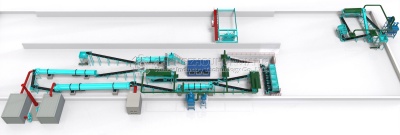In the wonderful world of fertilizer production, wet granulation is a very characteristic process, which shows its unique charm in the fertilizer production line.

The importance of fertilizers to agriculture is self-evident, it is a key source of nutrients for crops to thrive. A complete fertilizer production line is like a magical factory that converts various raw materials into high-quality fertilizer products.
In the process of wet granulation, the first is the preparation stage of raw materials. The basic raw materials needed for various fertilizers, such as compounds containing nitrogen, phosphorus, potassium and other elements, are transported to the front of the production line. These raw materials undergo rigorous quality testing to ensure their purity and quality meet production requirements.
Then comes the crucial mixing process. At this stage, the raw material is fully mixed with an appropriate amount of liquid medium (usually water or other special solvents) in a specific mixing equipment. The mixing device acts like a super mixer, ensuring that the ingredients and liquid are evenly combined to form an even paste.
Then comes the granulation stage, which is the core of wet granulation. The paste is transported to the granulator, and the special mechanical structure and process parameters are set inside the granulator to make the paste gradually form particles. These particles continue to roll and collide in the granulator, and gradually become round and uniform in size.
In the fertilizer production line, drying equipment with wet granulation also plays an important role. The newly formed wet particles are fed into the drying equipment, where the moisture in the particles is quickly removed through a high temperature and ventilation system, so that the particles become dry and stable. This step ensures that the fertilizer will not deteriorate or clump due to moisture problems during storage and transportation.
In short, wet granulation is an efficient and important process in fertilizer production lines. It converts raw materials into high-quality fertilizer pellets through a series of carefully designed links, providing a reliable nutrient guarantee for agricultural production and promoting the development of agriculture in a more efficient and sustainable direction.
